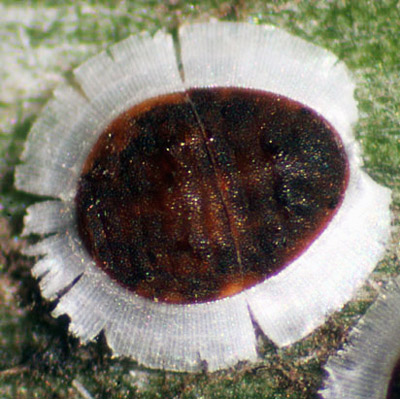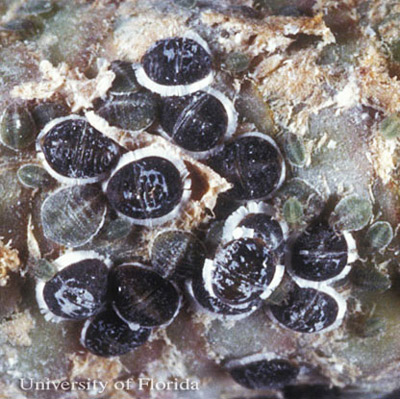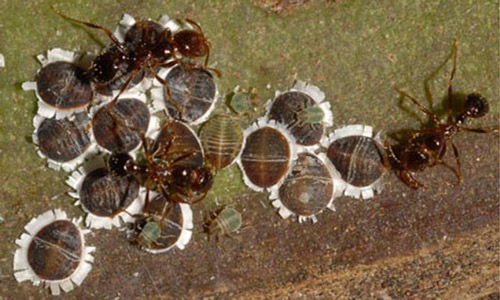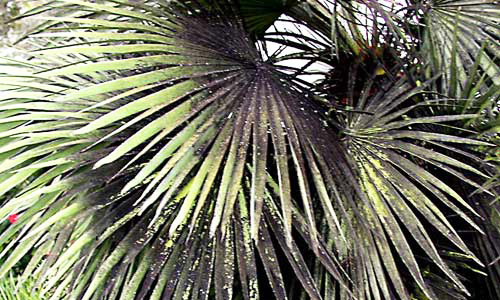common name: palm aphid
scientific name: Cerataphis brasiliensis (Hempel) (Insecta: Hemiptera: Aphidae: Hormaphidinae)
Introduction - Synonymy - Distribution - Description - Life Cycle - Hosts - Economic Importance - Management - Selected References
Introduction (Back to Top)
The palm aphids, Cerataphis brasiliensis (Hempel) and Cerataphis lataniae (Boisduval), are the only aphids known to infest palm plants. These species are differentiated by the presence of dagger-like setae—a highly variable morphological trait occurring in Cerataphis brasiliensis. This makes some taxonomists question whether the two are actually separate species. These two Cerataphis species, along with Cerataphis orchidearum, the orchid aphid, are commonly confused. The palm aphid can be a major pest of young landscape palms, especially coconut palms (Cocos nucifera L.).
Figure 1. Adult palm aphid, Cerataphis brasiliensis (Hempel). Photograph by David Cappaert, Department of Entomology, Michigan State University.
Synonymy (Back to Top)
Ceratovacuna brasiliensis Hempel (1901) Astegopteryx fransseni Hille Ris Lambers (1933)
Aleurocanthus palmae Ghesquiere (1934)
Cerataphis palmae Ghesquiere (1947)
Cerataphis fransseni Hille Ris Lambers (1953)
Cerataphis variabilis Hille Ris Lambers (1953)
Distribution (Back to Top)
Cerataphis brasiliensis is native to Southeast Asia but commonly occurs on host plants in tropical humid regions worldwide, both outdoors and in greenhouses. This aphid likely was disseminated by international commerce of living palm plants beginning in the early 20th century (Howard et. al 1998).
In the United States, this aphid is common in southern Florida, but rare north of Lake Okeechobee. The palm aphid has been reported in the following Florida counties: Brevard, Broward, Hillsborough, Lee, Manatee, Miami-Dade, Monroe, Orange, Palm Beach, Pinellas, Polk, St. Lucie and Seminole (Hunsberger et al. 2006).
Description (Back to Top)
The palm aphid does not look like a typical aphid; rather, it resembles a whitefly or scale insect. The palm aphid has a slightly convex to flat, oval-shaped body with a white, waxy fringe. In all life cycle stages of the aphid, a pair of small spikes, or horns, occur on the frontal head region. The horns appear to be used for offensive and defensive dueling at feeding sites (Howard et al. 1998). In addition, some individuals have several pairs of small dagger-like setae on the ventral side of the head.
Adults: Adult palm aphids are wingless and have an oval, slightly convex body that is dark brown and glossy with a peripheral fringe of white wax plates. They range in size from 1 to 2 mm long. Abdominal segments are evident on adult aphids but they are more distinctive on nymphs. A distinctive transverse suture in the middle of the dorsum, or back, divides the body, and a short free segment called a cauda occurs at the anal end of the body from which they can forcibly eject honeydew droplets up to 1/2 inches away. Adult palm aphids have short, cone-like, abdominal tubes called siphunculi, through which it is believed they exude droplets of waxy defense compounds. Two eyes appear as dark spots that are flush with the surface of the body. The aphids have functional legs, but remain mostly sedentary unless disturbed. Palm aphid adults are commonly confused with whitefly pupae.
Nymphs: Cerataphis brasiliensis has three nymphal stages. Nymphs are smaller (up to 1 mm long) than adults and have a light green to olive color body that is oval and slightly convex and contains a white waxy fringe on dorsal edges. Abdominal segments of the nymphs are evident, and a mid-dorsal ridge occurs on the head and thorax. Functional legs can be seen hidden under the body.
Figure 2. Adults (dark brown) and nymphs (light green or olive) of the palm aphid, Cerataphis brasiliensis (Hempel). Photograph by Lyle J. Buss, University of Florida.
Life Cycle (Back to Top)
The palm aphid is usually found on the unopened fronds and the youngest two or three fronds and occasionally on young fruits of the host palms. The aphids can appear motionless while feeding for long periods of time. Palm aphids are associated with ants and involve the typical mutualistic ant-aphid relationship where ants supply protection to the aphids and derive honeydew for their consumption.
Figure 3. Ants exhibiting mutualistic relationship with the palm aphid, Cerataphis brasiliensis (Hempel). Photograph by Lyle J. Buss, University of Florida.
In its native host range, Cerataphis brasiliensis is polymorphic and alternates its life cycle between a dicotyledonous primary host, Styrax benzoin, and monocotyledonous secondary hosts in the family Arecaceae (palms). Cerataphis brasiliensis is capable of surviving and reproducing on palms alone, without the primary host. However, only parthenogenetic reproduction occurs in the absence of the dicot host. Second-instar sterile soldiers are produced on the secondary host (Aoki and Kurosu 2010). In Florida, where Styrax benzoin is not present, multiple generations of the palm aphid can develop per year. Especially high populations can be observed during warmer months, allowing them to become pests of several palm species.
In the presence of the primary dicot host, sexual reproduction occurs and colonies are formed within galls. The gall forming aphid, or fundatrix, transforms an axillary bud of Styrax benzoin into a sac-like, single-cavity gall. The walls of the gall become lignified and hardened, unlike the softer walled galls of related species (Aoki and Kurosu 2010). The gall inhabiting colony is guarded by a first instar sterile soldier caste of the aphid that attempts to protect the colony from predation (Stern 1995). Predacious larvae and adults of Mimemodes spp. beetles have been identified within galls of Cerataphis brasiliensis. Interestingly, syrphid larvae, the most common aphid predators, and parasitoid wasps, have not been found in association with Cerataphis brasiliensis galls. The palm aphid will also induce galls of different species on the same host tree (Aoki and Kurosu 2010).
Hosts (Back to Top)
Cerataphis brasiliensis alternates between two host species in its native range. Colonies are formed within galls on the dicotyledonous tree Styrax benzoin and live externally on the green tissue of palm species. However, palm aphids can survive exclusively on palms where Styrax does not exist. The palm aphid infests several species of palms but prefers the 'Malayan Dwarf' variety of coconut palm (Coco nucifera). Other hosts of the palm aphid include the date palm, Phoenix dactylifera; the Chinese fan palm, Livistonia chinensis; the Alexander palm, Ptychosperma elegans; and the Washington palm, Washingtonia robusta.
Economic Importance (Back to Top)
High populations of palm aphids occasionally become severe in nurseries and the landscape. Palm aphids can cause substantial damage to young coconut palms. Palm aphids pierce palm foliage and suck out the plant phloem content, causing yellowing of the tissues and loss of plant vigor. In addition, honeydew production by the aphids promotes sooty mold growth that can limit photosynthesis. Palms heavily infested with aphids can experience stunted growth.
Figure 4. Sootymold, on palm fronds, growing on honeydew released by feeding from the palm aphid, Cerataphis brasiliensis (Hempel). Photograph by Douglas Caldwell, University of Florida.
Management (Back to Top)
Carefully monitoring newly purchased palms for the presence of aphids is the first line of defense for their management in the landscape. Excluding these pests in the landscape will help prevent damaging outbreaks. If high populations of palm aphids are observed, the use of biological controls can be successful due to the aphids' limited mobility on plants. Syrphid (Diptera: Syrphidae) and ladybird beetle (Coleoptera: Coccinellidae) larvae commonly feed on palm aphids and can be released for control of palm aphid infestations (Howard 2001).
Palms should be monitored for sooty mold production to determine if they are infested with aphids. Homeowners should scout their palms monthly for the presence of both aphids and natural enemies. If high populations of aphids are observed with few to no natural enemies present, horticultural oil can be applied for control. For professional growers of palms, an insecticide may be necessary for control. Numerous insecticides are labeled for aphid control, yet the most efficacious product for the control of Cerataphis brasiliensis has not yet been determined. Pyrethroids can kill natural enemies and should be considered as a last option only.
Selected References (Back to Top)
- Aoki S, Kurosu U. 2010. A review of the biology of Cerataphidini (Hemiptera, Aphididae, Hormaphidinae), focusing mainly on their life cycles, gall formation, and soldiers. Psyche 2010: 1-34.
- Denmark HA. 1965. The palm aphid, Cerataphis variabilis H.R.L. Florida Department of Agriculture and Consumer Services, Division of Plant Industry Entomology Circular 41. (26 April 2016)
- Enobakhare DA. 1994. Occurrence and distribution of Cerataphis palmae (Ghesquierei) (Homoptera: Pemphigidae) on Raphia palms in southern Nigeria. Insect Science and its Applications 15: 101-104.
- Howard J. 2001. Insects of Palms. CAB International. 400 pp.
- Howard FW, Halbert S, Giblin-Davis R. 1998. Intraspecific dueling in palm aphids, Cerataphis brasiliensis (Homoptera: Hormaphididae). Florida Entomologist 81: 552-554. (26 April 2016)
- Hunsberger A, Gabel K, Mannion C, Buss EB, Buss L. (August 2006). Palm Aphids (Cerataphis spp.). Tropical Research and Education Center. (26 April 2016)
- Josephraikumar A, Rajan P, Mohan C, Krishnakumar V. 2011. Report of the palm aphid, Cerataphis brasiliensis on 'Kalparaksha' coconut cultivar. Phytoparasitica 39: 389-391.
- Mews C, Cabette S, Albino J. 2008. A closer look at intraspecific variation of Cerataphis brasiliensis (Hempel) (Hemiptera: Hormaphididae). Neotropical Entomology 37: 137-142.
- Redford A, Walters T, Hodges A, Howard FW, Trice M. (October 2010). A Resource for Pests and Diseases of Cultivated Palms. Identification Technology Program. (26 April 2016)
- Reinert JA, Woodiel NL. 1974. Palm aphid control on 'Malayan dwarf' coconut palms. The Florida Entomologist 57: 411-414. (26 April 2016)
- Russell LM. 1996. Notes on Cerataphis brasiliensis and synonyms palmae, variabilis and fransseni (Homoptera: Aphididae), with a key to Cerataphis species living on palms and orchids. Proceedings of the Entomological Society of Washington 98: 439-449.
- Stern D. 1995. Phylogenetic evidence that aphids, rather than plants, determine gall morphology. Proceedings of the Royal Society of London B 260: 85-89.
- Stern D, Aoki S, Kurosu U. 1995. The life cycle and natural history of the tropical aphid Cerataphis frasseni (Homoptera: Aphididae: Hormaphidinae), with reference to the evolution of host alternation in aphids. Journal of Natural History 29: 231-242.



